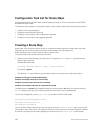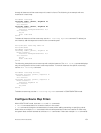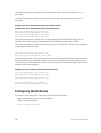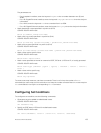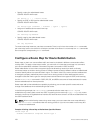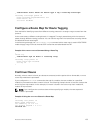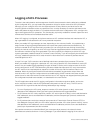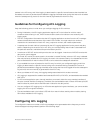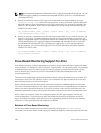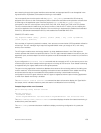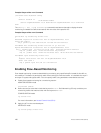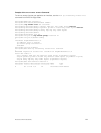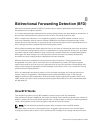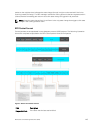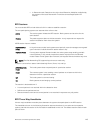
NOTE: This example describes the configuration of ACL logging for standard IP access lists. You can
enable the logging capability for standard and extended IPv4 ACLs, IPv6 ACLs, and standard and
extended MAC ACLs.
1. Specify the maximum number of ACL logs or the threshold that can be generated by using the
threshold-in-msgs count option with the seq, permit, or deny commands. Upon exceeding the
specified maximum limit, the generation of ACL logs is terminated. You can enter a threshold in the
range of 1-100. By default, 10 ACL logs are generated if you do not specify the threshold explicitly.
CONFIG-STD-NACL mode
seq sequence-number {deny | permit} {source [mask] | any | host ip-address}
[log [threshold-in-msgs count] ]
2. Specify the interval in minutes at which ACL logs must be generated. You can enter an interval in the
range of 1-10 minutes. The default frequency at which ACL logs are generated is 5 minutes. If ACL
logging is stopped because the configured threshold has exceeded, it is re-enabled after the logging
interval period elapses. ACL logging is supported for standard and extended IPv4 ACLs, IPv6 ACLs,
and standard and extended MAC ACLs. Configure ACL logging only on ACLs that are applied to
ingress interfaces; you cannot enable logging for ACLs that are associated with egress interfaces.
CONFIG-STD-NACL mode
seq sequence-number {deny | permit} {source [mask] | any | host ip-address}
[log [interval minutes]]
Flow-Based Monitoring Support for ACLs
Flow-based monitoring conserves bandwidth by monitoring only the specified traffic instead of all traffic
on the interface. It is available for Layer 2 and Layer 3 ingress traffic. You can specify traffic using standard
or extended access-lists. This feature copies all incoming packets on one port and forwards (mirrors)
them to another port. The source port is the monitored port (MD) and the destination port is the
monitoring port (MG).
The port mirroring application maintains and performs all the monitoring operations on the chassis. ACL
information is sent to the ACL manager, which in turn notifies the ACL agent to add entries in the CAM
area. Duplicate entries in the ACL are not saved.
When a packet arrives at a port that is being monitored, the packet is validated against the configured
ACL rules. If the packet matches an ACL rule, the system examines the corresponding flow processor to
perform the action specified for that port. If the mirroring action is set in the flow processor entry, the
destination port details, to which the mirrored information must be sent, are sent to the destination port.
When a stack unit is reset or a stack unit undergoes a failure, the ACL agent registers with the port
mirroring application. The port mirroring utility downloads the monitoring configuration to the ACL
agent. The interface manager notifies the port mirroring application about the removal of an interface
when an ACL entry associated with that interface to is deleted.
Behavior of Flow-Based Monitoring
Activate flow-based monitoring for a monitoring session by entering the flow-based enable
command in the Monitor Session mode. When you enable this capability, traffic with particular flows that
138
Access Control Lists (ACLs)



